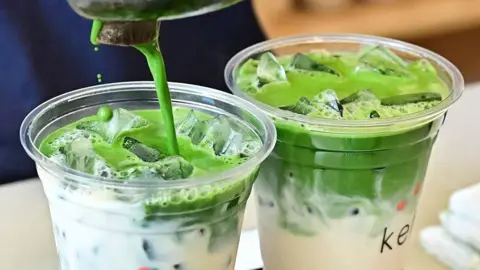The world’s growing fascination with matcha, a finely ground green tea originating from Japan, has reached unprecedented levels, creating a perfect storm of demand that is significantly impacting global supply. Recently, matcha has transitioned from a specialty item to a mainstream phenomenon, appearing in various products ranging from lattes at Starbucks in the UK to doughnuts at Krispy Kreme in Singapore. This surge in popularity is influenced by social media, where platforms like TikTok showcase inventive recipes and brewing tips under the trending hashtag “Matcha Tok,” amassing millions of views. This online enthusiasm coincides with Japan’s post-pandemic tourism boost, as the nation becomes an attractive destination thanks to its weak currency, driving up the interest in Japanese goods, including matcha.
As demand skyrockets, suppliers are facing challenges in keeping pace with the frenzied consumption. According to Lauren Purvis, a U.S.-based tea importer and owner of Mizuba Tea Co., her clients are reporting that customary monthly supplies of matcha are being depleted in a matter of days. “Some cafes are even asking for a kilogram a day. They’re desperate to keep up,” says Purvis. Such explosive demand is exacerbated by smaller tea crop yields resulting from extreme heatwaves and U.S. tariffs on Japanese imports, which contribute to increasing matcha prices.
Traditionally, matcha is produced through a meticulous and time-honored process involving shade-grown green tea leaves, known as tencha. These leaves are routinely cultivated and nurtured under specific conditions to develop their unique umami flavor—a savory taste that balances both sweetness and earthiness. Once harvested, the leaves undergo a drying process before being ground into a fine powder using traditional stone mills—capable of producing a mere 40 grams of matcha per hour. However, record-breaking heat has adversely affected crop outcomes, particularly in Kyoto, which accounts for roughly a quarter of Japan’s tencha. Additionally, the country faces a demographic crisis, as an aging population and an insufficient influx of younger workers deter new entrants into the farming sector.
Tourist hotspots in Uji, a city renowned for matcha, often find their shelves stripped bare moments after opening for business. To manage the scarcity, retailers are compelled to restrict customer purchases, as exemplified by Camellia Tea Ceremony, where customers are limited to purchasing only one tin of matcha each. Atsuko Mori, director of the establishment, notes that the number of visitors has doubled in the past year. Similarly, Rie Takeda, a tea master working for the Tokyo-based Chazen tea ceremony chain, highlights increased waiting times for stock replenishments, affecting operational efficiency, as prices at their outlets have spiked by approximately 30% this year.
In light of the situation, there has emerged a movement for more mindful consumption of matcha. Advocates express concerns over individuals hoarding supplies or exploiting the trend for profit. There is a push for consumers to appreciate the tea in its authentic form rather than masking its delicate profile with other ingredients. “It’s a bit sad to see high-grade matcha used in cooking, where its subtle flavor is often lost,” remarks Mori, highlighting the incongruities of the current market practices.
To alleviate pressures on high-quality matcha, the Global Japanese Tea Association recommends utilizing lower-grade matcha from subsequent harvests, which is more abundant and better suited for culinary purposes. The organization stresses that elevating consumer awareness regarding different grades of matcha can help ensure that Japanese tea traditions are honored while supporting the craftsmanship that goes into its production.
The trade landscape is also shifting, as recent tariffs imposed by the U.S. increase tensions and costs on Japanese imports, including matcha. Following an announcement on a trade deal introducing a 15% import tax, distributors braces for further price hikes. However, optimism remains in the air, with market players like Masahiro Nagata of Matcha Tokyo mentioning that although the current demand surge is impressive, market trends may stabilize in the next two to three years. Thus, while the matcha craze continues to thrive, the journey ahead may require more prudent consumption patterns and an adaptation to changing market dynamics.












